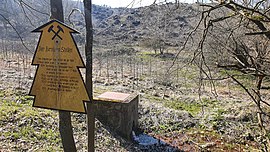deep pear tree tunnel
| deep pear tree tunnel | |||
|---|---|---|---|
| General information about the mine | |||
| Mundloch and Dennert Tanne in March 2020 | |||
| Mining technology | Underground mine | ||
| Information about the mining company | |||
| Start of operation | 1764 | ||
| End of operation | 1903 | ||
| Funded raw materials | |||
| Degradation of | |||
| Greatest depth | 90 m | ||
| Geographical location | |||
| Coordinates | 51 ° 36 '57.5 " N , 11 ° 5' 18.1" E | ||
|
|||
| local community | Neudorf | ||
| District ( NUTS3 ) | resin | ||
| country | State of Saxony-Anhalt | ||
| Country | Germany | ||
| District | pear tree | ||
The deep pear tree tunnel , in the pear tree valley southwest of Silberhütte , is the longest and deepest water solution tunnel in the Lower Harz pond and ditch system in the Harz mining region . The water is on the receiving water Birnbaum trench parallel to Birnbaum stream in the Selke (the mouth near the former access to the Rinke mill ) dissolved .
history
In mining in the “Birnbaum Revier”, on the Straßberg-Neudorfer-Gangzug , the Elisabeth Albertine mine , which had been the most important until then, was closed in 1764 after around 20 years of mining activity. The Silberhütter Kunstgraben had not yet reached the Birnbaumer Revier at this point and the dewatering proved to be very difficult. The Albertine shaft of the Elisabeth Albertine mine was relatively deep with a depth of 272 m . In addition, the terrain was so unfavorable that the artificial bike had to be set up around 1,200 meters away. After that, in the Anhalt Harz ( Principality of Anhalt-Bernburg and Principality of Anhalt-Harzgerode ), the focus was initially on the Biwender Gangzug . The deep pear tree tunnel, which began in 1762, only reached the Selke area at that time .
From the middle of the 18th century, the Pfaffenberg tunnel was explored on the Straßberg-Neudorfer gangway . The pit Meiseberg and the adjacent later durchschlägige to Meiseberg pit Pfaffenberg proved in the following decades as a particularly productive, but by the great for the Unterharz depths problematic in the drainage .
Thus, in 1792/93, the planned expansion of the drainage system in Neudorf began. The Silberhütter Kunstgraben could be extended through the Neudorfer Graben to the Neudorfer community pond and now brought additional water from the Lude and the Neue Graben from the Kalbsaugen pond . This made it possible to operate surcharges and from 1810 the Meiseberg mine began to harvest. As before, the water solution in all Neudorf mines proved difficult, in many mines impossible. Therefore, the deep pear tree tunnel was driven forward, which enabled the Birnbaumer pits in the Straßberg-Neudorfer gangway to be resumed from 1814. 1815 with the synthetic shaft and the drive shaft in the front Birnbaum and 1827 with the Kunstschacht Glücksstern durchschlägig , already 78 meters depth have been reached.
In the Meiseberg mine, the miners are still fighting with the water. The Pfaffenburger tunnel in the valley of the narrow Wipper brought a depth of only 31 meters to the Meiseberg mine and the extension is only 45 meters deep. The ore was up to 360 m in the Pfaffenberg mine and up to 220 m in the Meisenberg. The arts were unable to cope with the amount of water produced. Therefore the deep pear tree tunnel was extended again.
In 1865 this broke through to the Meisebergschacht, where the maximum depth of 90 meters was reached. The penetration to the Pfaffenbergschacht was only reached in 1882. Since the mountain was almost crossed here, there was only a depth of 60 meters. The water solution now took place in two stages. While the upper stretches were loosened via the Pfaffenburg tunnel, the water on the lower stretches was loosened via the deep pear tree tunnel.
The current state is not known. The deep pear tree tunnel, however, still carries away water from the drained pits . The emerging water was used for the local water supply until at least the end of the 1970s. The current construction of the tunnel mouth hole is a functional building erected in the early 1960s.
particularities
The deep pear tree tunnel is not only the deepest and by far the longest water solution tunnel in the Lower Harz. The other water solution tunnels of the Unterharzer pond and trench system are otherwise only a maximum of 2100 meters in length. Under the Meisberg the deep Birnbaum tunnel passes under the watershed of Selke and Wipper . While the Pfaffenburger tunnel ends in front of the above-ground Silberhütter Kunstgraben and the underground water of the Wipper catchment area also dissolves into the Wipper, the deep pear tree tunnel releases the water in exactly the other direction, in the significantly lower Selketal. This is the reason for the great length and depth. Without this tunnel , mining in Neudorf would have come to a standstill much earlier.
swell
- Wilfried Ließmann: Historical mining in the Harz . 3. Edition. Springer, Berlin 1997, ISBN 978-3-540-31327-4 .
- Development and current function of systems of historical mining water management in the Lower Harz . In: Wilfried Strenz, Working Group Historical Geography of the Geographical Society of the GDR (ed.): Historical-geographical research in the GDR . Hermann Haack Geographisch-Kartographische Anstalt, Gotha 1986, ISBN 3-7301-0803-4 .
- The Lower Harz pond and ditch system
- Mining Firs - Neudorf

